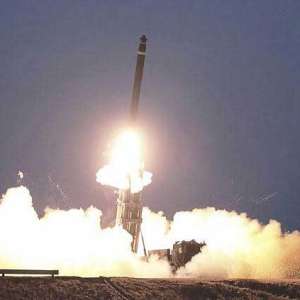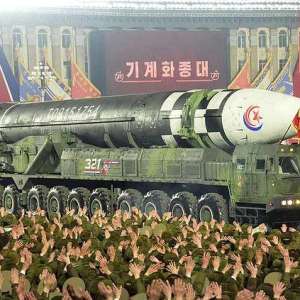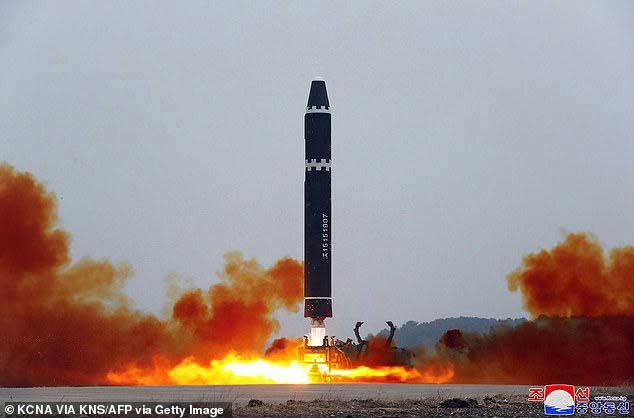North Korean ICBM could hit US in 33 minutes due to gaps in America's missile defence, study claims
Story by Christian Oliver • 7h ago - 16-3-2023
North Korea could launch an intercontinental ballistic missile at the United States that would hit the country in just 33 minutes, China has claimed.
Scientists in Beijing have simulated the ICBM launch and believe Pyongyang would be able to hit the country should the U.S.'s nuclear defence fail to intercept the missile.
The team of scientists from the Beijing Institute of Electronic System Engineering said North Korea's nuclear-capable Hwasong-15 missile with a range of over 8,000 miles (around 13,000 kilometres) would be 'sufficient to hit the entire US homeland'.
The simulation also suggested that there were gaps in the U.S. nuclear defence armoury.
The scientists said their tests showed the existing US missile defence network had gaps in its 'kill chain' and would struggle to identify and defend against an attack.
The new research and simulation published by China's top institute for aerospace defence was led by scientist Tang Yuyan and released in the Modern Defence Technology Journal for February.
The simulation started with a launch from Sunchon, a North Korean city south of capital Pyongan, and targeted Columbia in Missouri. The specific location was selected for its centrality in the middle of America.
Running the tests, the team said a theoretical launch would cause the U.S. to receive an alert 20 seconds later.
Within 11 minutes, the U.S.'s nuclear defence would fall into action as intercepting missiles would blast out of Fort Greely in Alaska's Southeast Fairbanks Census Area.]
A second phase of missiles would then launch Vandenberg Space Force Base in California should the first defence fail.
Tang's team said the U.S. defence was impressive but they said the simulation identified some gaps in the 'kill chain' that a nation such as North Korea could exploit.
The study claimed that the reason for the research was to evaluate the effectiveness of U.S. nuclear defence capabilities.
The most recent simulation follows another Chinese study released earlier this year which marked potential targets for China's hypersonic weapons.
The first wave of a hypothetical attack would aim at some of the largest ground-based radars in the U.S., the study said.
It would target Beale Air Force Base in California’s Yuba county and the Cape Cod peninsula.
Those bases were identified as they would be vulnerable to hypersonic weapons that are able to move unpredictably and strike at five-times the speed of sound, the study said.
The study also follows continued launching and testing of several ballistic missiles by North Korea.
Story by Christian Oliver • 7h ago - 16-3-2023
North Korea could launch an intercontinental ballistic missile at the United States that would hit the country in just 33 minutes, China has claimed.
Scientists in Beijing have simulated the ICBM launch and believe Pyongyang would be able to hit the country should the U.S.'s nuclear defence fail to intercept the missile.
The team of scientists from the Beijing Institute of Electronic System Engineering said North Korea's nuclear-capable Hwasong-15 missile with a range of over 8,000 miles (around 13,000 kilometres) would be 'sufficient to hit the entire US homeland'.
The simulation also suggested that there were gaps in the U.S. nuclear defence armoury.
The scientists said their tests showed the existing US missile defence network had gaps in its 'kill chain' and would struggle to identify and defend against an attack.
The new research and simulation published by China's top institute for aerospace defence was led by scientist Tang Yuyan and released in the Modern Defence Technology Journal for February.
The simulation started with a launch from Sunchon, a North Korean city south of capital Pyongan, and targeted Columbia in Missouri. The specific location was selected for its centrality in the middle of America.
Running the tests, the team said a theoretical launch would cause the U.S. to receive an alert 20 seconds later.
Within 11 minutes, the U.S.'s nuclear defence would fall into action as intercepting missiles would blast out of Fort Greely in Alaska's Southeast Fairbanks Census Area.]
A second phase of missiles would then launch Vandenberg Space Force Base in California should the first defence fail.
Tang's team said the U.S. defence was impressive but they said the simulation identified some gaps in the 'kill chain' that a nation such as North Korea could exploit.
The study claimed that the reason for the research was to evaluate the effectiveness of U.S. nuclear defence capabilities.
The most recent simulation follows another Chinese study released earlier this year which marked potential targets for China's hypersonic weapons.
The first wave of a hypothetical attack would aim at some of the largest ground-based radars in the U.S., the study said.
It would target Beale Air Force Base in California’s Yuba county and the Cape Cod peninsula.
Those bases were identified as they would be vulnerable to hypersonic weapons that are able to move unpredictably and strike at five-times the speed of sound, the study said.
The study also follows continued launching and testing of several ballistic missiles by North Korea.
3 yr. ago




